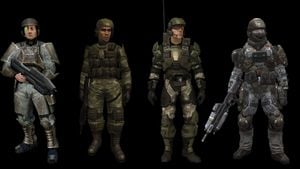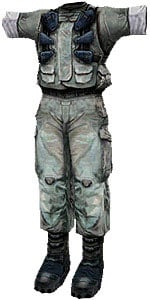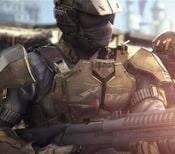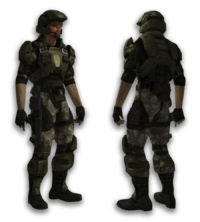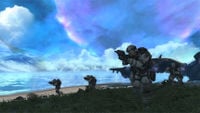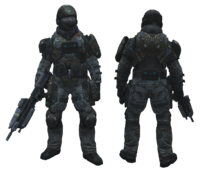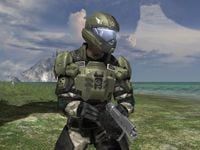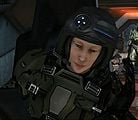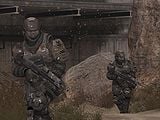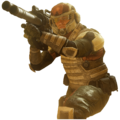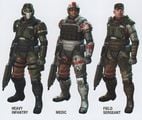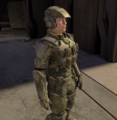UNSC Marine Corps Battle Dress Uniform
From Halopedia, the Halo wiki
Battle Dress Uniform (BDU) is a broad term describing any of several standard-issue combat uniforms worn by members of the UNSC Marine Corps.
Overview
Unlike the Marine Corps Dress Uniform, which is worn at parades and functions, the BDU is intended for use in combat situations. Though the Marine Corps fields a great variety of BDU types, all models comprise armor plating over camouflaged combat utilities, as well as a CH252 helmet and combat boots. Ammunition pockets, holsters, and rucksacks are commonly used in conjunction with the BDU.
Unlike the MJOLNIR Powered Assault Armor worn by the Spartan supersoldiers, the Marine BDU does not include a recharging energy shield, providing inferior protection against directed energy and projectile weapons.
Ushuaia Armory performed a substantial amount of work on at least one version of the BDU.[1]
Components
Fatigues
- Main article: Fatigues
Camouflaged combat utilities are worn under the armor plating. Woodland, desert, and urban camouflage are the most common color patterns for Marine fatigues.
Combat boots
Combat boots such as the VZG7 armored boots are worn with the uniform. They are sometimes equipped with different types of additional armor to provide greater protection to the lower leg.
Armor
The Marine BDU is equipped with one of various models of ballistic armor at multiple points, including the torso, the shoulders, and the shins. The most common version incorporates armour for the forearms, thighs, and groin as well. The armour is resilient against traditional ballistic weaponry, but is also resilient against plasma weaponry. While different iterations of the BDU feature different armor models, all possess roughly equivalent durability. Lighter body armor, such as the ballistic assault vest, is used in lieu of standard-issue gear during some operations.
Headgear
- Main article: CH252 helmet
All iterations of the BDU feature one of several versions of the standard-issue CH252 helmet, which is painted to match the corresponding body armor. The helmet may be mounted with various accessories, such as a holographic tactical eyepiece, a helmet recorder, a boom microphone, polarized tactical goggles, a flashlight, or a night vision device. Marines sometimes wear balaclavas with their helmets, both in frigid and temperate climates. In hazardous situations, gas masks such as the S90 gas mask are worn.
Marines on field operations in more humid locales sometimes choose to wear Boonie covers. Marine non-commissioned officers are easily recognized by the cover that they wear, which features the UNSC insignia, although they often substitute this soft cover for a more protective helmet.
Primary models
Several versions of the Battle Dress Uniform are in service, one of which is shared with the Army and the Air Force.[2] The issue of any given model depends on environmental conditions, combat type, and the wearer's role.[3]
Insurrection era model
The earliest known iteration of the Marine Corps BDU was in use during the Insurrection[4] and continued to see service well into the Human-Covenant War and the post-war era, with some units fielding this model as late as 2557.[5] Notably, this model was standard issue during the Harvest campaign.[6][7] The fatigues have a two-tone greenish gray camouflage,[8] whereas the armor is issued in both reflective drab and matte forest green.[9] The cold environment fatigues use the same camouflage pattern with white in place of green; similarly colored armor and a matching helmet are worn with this version.[10] The shoulder pauldrons for this model come in at least two designs: the standard version has a broad, concave form that covers the shoulder and most of the upper arm,[11][9] while an off-hand variant is thicker and sits higher on the arm, extending well beyond the shoulder.[10] Marines issued this variant often wear polarized tactical goggles and balaclavas, even in temperate environments. The chestpiece used with this model is composed of very heavy plating. The forearms, shins, and boots are fully armored. Some users wear tactical thigh rigs or holsters, while some wear armor covering the thighs. Often the left thigh is armored while a holster is attached to the right thigh.
BDU with M52B body armor
This version of the BDU had entered service by 2531[7] and was used by Marines on Earth, Kholo,[12] Algolis,[13] Sigma Octanus IV,[14] Reach,[15][16][17], and numerous other planets. This model is based around the M52B body armor, which can be outfitted with various accessories such as utility webbing and ammunition pouches; the armor is supported by a black ballistic vest that extends to the arms. The armor and helmet used in conjunction with this model are almost universally painted olive drab, while the fatigues generally feature a woodland camouflage pattern.[note 1]
This version of the BDU lacks the prominent shin armor used with other models, with only the upper shin being armored. This version also lacks thigh armor, though some Marines wear lightly armored holsters on their thighs. The BDU has black knee and elbow pads, although they are only lightly armored. The uniform also includes armored pauldrons. The V7G7 boots worn with the system are covered in light armor plating. Marines often wear fingerless gloves with this model.
The armor used in training officer cadets at the Corbulo Academy of Military Science in 2526 appeared to be a smaller, lighter version of the standard M52B armor and bore the Academy's emblem on the chest plate. It shared the shoulder pauldrons of the full-sized model.[18]
Cross-branch BDU
This version of the Battle Dress Uniform is shared with the Army and the Air Force.[2] It features gray fatigues with dust brown or gray-brown armor plating covering the head, torso, shoulders, thighs, and shins. At times Marines wear only their utilities and soft body armor, even forgoing helmets and body armor plating in hazardous combat operations, sometimes substituting their helmets for Boonie covers or bandannas. Some Marines have small medical packs built into their back armor plating. Many helmets worn with this system include a holographic tactical eyepiece.[note 2]
This version's armor protects the front and back of the torso as well as the groin. The vest incorporates separate upper-arm components with clips which allow the attachment of various types of pauldrons. Marines equipped for combat in a normal atmosphere are typically equipped with a GUNGNIR pauldron on the left shoulder and a larger universal pauldron on the right one; the pauldron displays the UNSC logo and lettering and sometimes displays a diagonally crossed hexagon, which is also present on the Army BDU.[19] Meanwhile, space-ready Marines use a configuration of a single universal pauldron on the left shoulder and a smaller UA/Base Security shoulder armor on the right shoulder, which displays the Marine's blood type under UNSC lettering.[20]
For leg protection wearers often utilize the UA/NxRA utility armor, which cover both thighs. Wearers often use heavily armored knee guards distinct from those worn by the Army. Some Marines wear heavier shin armor along with GUNGNIR knee guards. Marines who wear the pressurized Atmospheric/Exoatmospheric (A/X)[21] version of this BDU, such as to mitigate the atmospheric hazards caused by nearby glassing,[20] wear an enclosed ECH252 helmet derived from the Beta-5 Division MP helmet, as well additional collar armor similar to that worn by Air Force pilots.[20]
Post-war BDU
A new version of the BDU entered widespread use after the end of the Covenant War, having seen a perhaps limited degree of use during the war.[22] A similar model, though distinct iteration was in service as early as 2526.[23] While the general arrangement of its armor sections remains largely similar to the prior variations, the ballistic vest underneath the armor is more prominent. As with the other versions of the suit there are a number of variations of the post-war BDU for different combatant roles, including several configurations for infantry, officers, communications specialists, and Corpsmen. While in most iterations of this model the helmet remains open in the front, one version used by infantry features a fully sealed face mask integrated to the standard helmet.[24]
This version is characterized by its twin-tone coloration; in addition to the primary color, the uniform has red sections on the inner portion of the legs, the neck, the upper part of the sleeves, and the sides of the torso. The primary color of the uniform is most commonly olive drab, although this is replaced by gray in the variant used by corpsmen. The armor sections usually match the primary color of the suit but may also be white, dark gray, or tan.[24]
The most widely used variant of the post-war BDU aboard the UNSC Infinity includes a larger, bulkier helmet and a ballistic vest worn over the basic uniform (wich is as resilient as the normal chest piece), with some armor plating around the boots and limbs.[24] The standard issue armor across all UNSC Marines, however, is a variant which features heavy plating around the torso, thighs, shins, shoulders, and forearms, worn with an "off-world helmet".[25]
The uniforms worn by the cadets at Corbulo Academy of Military Science shared many features with this version of the BDU, namely a similar ballistic vest and most of the armor sections. The cadet uniform also featured the distinctive two-color motif in the trousers, with the insides being either black or khaki brown.[23]
Variants
Pilot variant
Marine pilots usually wear a modified version of the standard Marine uniform,[26] though they are known to utilize the BDU without modifications as well. Several helmet models are used by pilots, including one version with a fully covering flip-down visor, which likely provides a heads-up display;[15] a similar model features a larger, gold-polarized visor.[27] Other pilots wear more advanced equipment, including fully sealed helmets and an additional control panel on the standard chest armor piece. Each helmet bears a wing symbol, possibly denoting the wearer's MOS, though this may instead indicate unit affiliation.[26]
Corpsman variant
While many Navy Corpsmen wear the standard BDU, some use a suit with charcoal fatigues and padding with white armor featuring red shoulder straps and caduceus symbols on the shoulder pauldrons for easy identification.[28]
Other suits
While the standard BDU is most commonly seen in the field, there are multiple specialized combat suits worn by different branches of the UNSC Marine Corps. The armor system utilized by the Orbital Drop Shock Troopers is the most notable example, being a sealed full-body combat suit instead of a more conventional armored uniform. During operations in vacuum, Marines wear vacuum suits, often equipped with armor plating. One example of a vacuum-enabled suit is the black body suit, which is a lightweight, form-fitting suit of polymer body armor. Other task-specific suits exists, such as the fire-resistant full-body combat suit worn by the Hellbringers. Heavier armored variants of the standard BDU were worn on counterinsurgency operations by 2524, including a suit with charcoal fatigues and matte-black heavy impact plating covering most of the body and a helmet that fully encases the head.[29]
Trivia

|
Browse more images in this article's gallery page. |
The Battle Dress Uniform as seen in Halo: Combat Evolved was heavily inspired by the armor worn by the Colonial Marines in the film Aliens, which greatly influenced the game.
Gallery
- 600px-Halo Wars Marine BR.jpg
Marines in the cold environment variant of the Insurrection-era BDU
A Bumblebee pilot wearing the M52B armor with a specialized helmet
List of appearances
Notes
- ^ The article describes this version of the BDU as it is seen in Halo 3 and later media, as it is a visually updated version of the BDU seen in Halo 2.
- ^ The article describes this version of the BDU as it is seen in Halo: Reach and Halo: Combat Evolved Anniversary, as it is a visually updated version of the BDU seen in Halo: Combat Evolved.
Sources
- ^ Halo: The Essential Visual Guide
- ^ a b Halo Encyclopedia (2011), pages 56 and 57
- ^ Halo: Combat Evolved Anniversary, Library - UNSC Marine and UNSC Armored Marine
- ^ Halo Legends: Origins
- ^ Halo: Spartan Strike (File:HSS-Cinematic-Holdouts.jpg)
- ^ Halo Wars
- ^ a b Halo Legends, Homecoming
- ^ Image showing subtle camouflage pattern
- ^ a b Halo 2 Anniversary, Sergeant Major Johnson's CGI model
- ^ a b Halo Wars, Sergeant Forge's armor
- ^ Halo Wars, standard Marine armor
- ^ Halo: Evolutions, The Return motion comic
- ^ Halo Legends, Prototype
- ^ Halo: Fall of Reach - Covenant
- ^ a b Halo: Combat Evolved Anniversary, campaign level Halo
- ^ Halo: Combat Evolved Anniversary - Terminals
- ^ Halo: Fall of Reach - Invasion
- ^ Youtube Halo 4: Forward Unto Dawn Official Full-length Trailer
- ^ Halo: Combat Evolved Anniversary
- ^ a b c Halo: Reach, campaign level The Pillar of Autumn
- ^ Halo Waypoint Forums: The UNSC Army discrepancy in CE can be fixed
- ^ Halo 4, Prologue cutscene
- ^ a b Halo 4: Forward Unto Dawn
- ^ a b c Halo 4 Marine NPC models
- ^ Halo 4: The Essential Visual Guide
- ^ a b Halo 3, campaign level The Covenant
- ^ Halo 2, campaign level Metropolis
- ^ Halo: Evolutions - Essential Tales of the Halo Universe, The Mona Lisa motion comic
- ^ Halo: Contact Harvest, page 9
